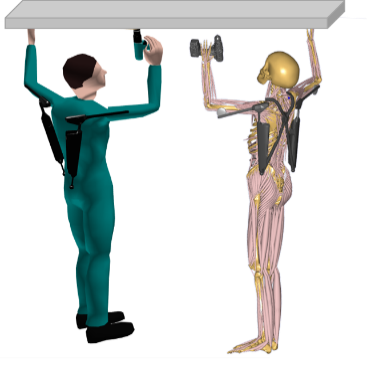Nikolas Förstls work on designing a temporary shoulder implant for measuring shoulder stiffness has been accepted for publication in the journal of Medical Engineering & Physics. The work adresses the clinical problem of adjusting the pre-tension of the shoulder muscles when a shoulder prosthesis is implanted. We developed a temoprary device which allows for measuring the stiffness. This could be the basis for more reliable and functional treatment. The co authors in the study were Franz Süß, Carsten Englert and Sebastian Dendorfer. The paper can be read here: https://www.sciencedirect.com/science/article/pii/S1350453323001145
New research project on Pelvic Floor Disorders
We have started a new research project on the prevention of Pelvic Floor Disorders. Pelvic Floor Disorder are widly used problem for may women and men, resulting in a severe reduction of quality of life.
Together with our partners from the University of West Bohemia Plzen and Charles University Praha we have successfully applied for a research grant in the programm Interreg Bayern-Tschechien 2021-2027. The total project budget is close to 1 Mio €.
Our aim is to investigate the biomechanics of Pelvic Floor and to develop prevention schemes which will be dissemeninated in the project region. Also through an integration of partners in the region we want to make a difference for patients. This is an exciting project for us as it combine basic research with a hopefully direct impact on people.
Paper in Sensors accepted
Lukas Reinkers work on sensors placement for reliable acceleration data has been accepted for publication in Sensors.
The titel of the paper is: Correlation of acceleration curves in gravitational direction for different body segments during high-impact jumping exercises.
It shows that many body locations at trunk and arms can be used for the analyses of accelerations acting at the body. We will use this info to develop prevention schemes for Osteoporosis.
Co Author to the study were Dominic Bläsing and Sabina Ulbricht, our partners from University Greifswald and Rudolf Bierl and Sebastian Dendorfer.
Dr. Maximilian Melzner
Maximilian Melzner sucessfully defended his PhD thesis on the 19th of January. His work on hand and elbow modeling and musculoskeletal simulations has been rated summa cum laude. The thesis has been reviewed by Prof. Christian Pfeiffer and Prof. DirkJan Veeger. PD Carsten Englert has been part of the examination committee and Prof. Sebastian Dendorfer was the supervisor of the research.
Congratulation! If you are interested have a look at the papers section on this page.
AnyBody Modeling Workshop 2023
Once again we are organizing a free of charge AnyBody Modeling Workshop. It will be aimed at beginners and will take place end of Mai. Follow the link for details and registration.
Paper on elbow stability published
Our study on the influence of injury patterns on elbow stability has been accepted for publication in the Journal of Orthopaedic Research. Maximilian Melzer was main author.
Presentation at OT World Congress
Some of the labs work has been presented by Sebastian Dendorfer at the OT World Congress 2022 in Leipzig. The presentation titel: “Biomechanische Aspekte bei Sportverletzungen”. Thanks to the organizers for the invitation to a great event.
Studienteilnehmer*Innen gesucht
Für ein Forschungsprojekt zur Verbesserung der Ergonomie beim Geigenspielen suchen wir noch Teilnehmer*Innen. Informationen zur Studie gibt es hier: https://lbm.rchst.de/studie-geige/
Young scientist award for Anne-Sophie Saffert
Anne-Sophie Saffert has won the Young Scientist Award of the Conference Biomdlore 2021, Vilnius/Lithuania!
She received the award for her paper: “Biomechanical Analysis of the Right Elevated Glenohumeral Joint in Violinists during Legato-Playing”.
In her paper, she was able to show the sometimes drastic forces that can occur due to poor posture in female violinists. The work is also published as a paper in a special edition of the journal Techology and Health Care. Co-authors of the study were Maximilian Melzner and Sebastian Dendorfer.
Start des Forschungsprojektes DigitalExonomics
Mit einem Kick-Off-Treffen am 30.09.2021 wurde das vom Bundesministerium für Bildung und Forschung geförderte Forschungsprojekt „DigitalExonomics: Digitale Arbeitsgestaltung und Ergonomiebewertung für die Anwendung industrieller Exoskelette“ gestartet. Das Verbundprojekt mit den Forschungseinrichtungen Fraunhofer IPA und OTH Regensburg sowie den Motion-Capturing Spezialisten von The Captury wird von den Ergonomieexperten der imk automotive GmbH unter der Leitung von Prof. Dr. Lars Fritzsche koordiniert. Seitens der OTH Regensburg ist das Labor für Biomechanik unter Leitung von Prof. Dr.-Ing. Sebastian Dendorfer im Projekt vertreten.
In den nächsten 30 Monaten wird untersucht welche Wirksamkeit Exoskelette als körpergetragene Unterstützungssysteme in verschiedenen Anwendungsfällen haben und wie sie in der digitalen Simulation von Arbeitstätigkeiten integriert werden können. Es wird eine innovative Methodik zur Untersuchung und Bewertung ergonomischer Auswirkungen des Tragens von Exoskeletten mit Hilfe von markerloser Bewegungserfassung und 3D-Menschmodellen (AnyBody und ema) entwickelt. Neben der Durchführung von Labor- und Feldstudien zu Validierungszwecken, hat sich das Projekt die Realisierung von Schnittstellen zwischen den Systemen und eines neuen Moduls zur Visualisierung und Analyse von Exoskeletten in der ema Software Suite zum Ziel gesetzt.
Wir freuen uns auf eine spannende und erkenntnisreiche Zeit im Forschungsprojekt „Digital Exonomics“!
